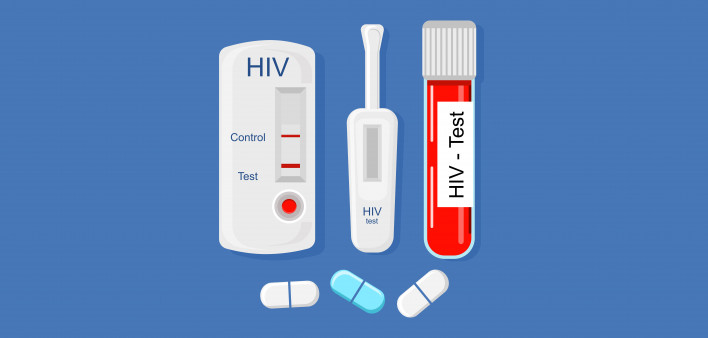National HIV testing rates dropped dramatically in 2020 as a result of the COVID-19 pandemic, according to new data released by the Centers for Disease Control and Prevention (CDC). The decrease was especially sharp for CDC-funded tests, which fell by almost half.
The data were released ahead of National HIV Testing Day (June 27), an observation dating back to 1995. This year’s theme is “HIV Testing is Self-care,” which is especially important two years into the pandemic.
Because testing is the first step toward accessing treatment and prevention services, including antiretroviral therapy and pre-exposure prophylaxis (PrEP), recovering from this interruption is essential to curbing HIV transmission.
“We welcomed 2020 with optimism,” Jonathan Mermin, MD, MPH, director of the CDC’s National Center for HIV, Viral Hepatitis, STD and TB Prevention, said in a media statement. “New HIV infections were declining, and attention to HIV was increasing. But just as COVID-19 disrupted our lives, it changed the course of HIV prevention. Now we are at a crossroads. Will we accept the massive reductions in HIV testing, or will we bounce back stronger?”
A team of researchers from the CDC’s Division of HIV Prevention, led by Elizabeth DiNenno, PhD, compiled national HIV testing and diagnosis data from various sources, including commercial laboratories, public and private providers and non-health care settings, from February 1 to December 31, 2020; these were compared to data from the previous year. The CDC published the findings in its Morbidity and Mortality Weekly Report.
Compared with the almost 14.3 million HIV tests recorded in 2019 across data sources, the CDC study found that just 11.6 million tests were recorded during the comparable period in 2020. That’s over an 18% drop across sites, likely resulting in thousands of missed or delayed diagnoses.
Though these testing data are not exhaustive and do not include certain commercial providers and self-tests, it paints a picture of how testing and diagnosis looked during the early stages of COVID-19.
Before the pandemic began, HIV testing in early 2020 was higher compared with the previous year, but it plummeted in March as COVID conditions worsened. At that time, many people went into lockdown to avoid exposure to the coronavirus, and regular health care was disrupted. Testing fell to its lowest point in early April, slowly recovering from there. But at the end of the year, testing remained below previous levels.
COVID-related interruptions particularly hurt CDC-funded sites. CDC-backed health care settings performed 43% fewer tests, and CDC-backed non-health care settings, such as dedicated HIV test sites and community events, performed 50% fewer tests. These CDC-funded public and community sites are essential for serving people with less access to health services, some of whom live in areas with higher transmission rates targeted by the national Ending the HIV Epidemic initiative.
The researchers found that testing rates fell across demographic groups, including key groups at higher risk for HIV. In non-health care settings, testing declined by 49% among gay and bisexual men, 47% among transgender people, 46% among Latino people and 44% among Black people. These groups, as well as people in regions like the South, continue to experience higher rates of HIV transmission, making routine testing a priority for public health officials.
During the same period, health care providers reported 17% fewer positive HIV diagnoses. But the decline does not necessarily mean a decrease in HIV incidence, since it coincided with the dramatic interruption in HIV services, including testing, sparked by the pandemic.
There are some limitations to the data. One is that the researchers cannot determine what proportion of the decrease in reported tests and diagnoses is due to interrupted health services, reduced testing because of perceived lower risk due to less sexual activity during the early pandemic or an actual decline in HIV incidence.
The pandemic roadblock follows years of progress in HIV testing and diagnosis. New cases fell by 8% between 2015 and 2019, largely thanks to widespread antiretroviral treatment and PrEP. In 2019, federal health agencies started Ending the HIV Epidemic, which aims to decrease HIV transmission by 90% over the next decade with a mix of targeted testing, treatment and prevention approaches. The program provides extra funding for communities facing higher HIV rates.
Coming back from the pandemic disruption will require teamwork. To counter missed diagnoses and get back on track with national prevention goals, the CDC urges a coordinated testing effort involving public, private and nonprofit agencies, especially targeting vulnerable populations. The CDC encourages everyone between ages 13 and 64 to get tested at least once, with regular testing based on potential exposure.
The recommendation includes self-testing kits, accurate tests that can be performed at home. When offered for free, self-testing does a great job of reaching people who have never been tested for HIV, according to earlier CDC data.
“Everyone should enjoy good health—and getting an HIV test is part of a successful plan to do so,” said Demetre Daskalakis, MD, MPH, director of the CDC’s Division of HIV Prevention. “Some people may not get tested for many reasons, such as concerns about HIV stigma, homophobia, transphobia and a host of other isms and phobias. Or they may not know that an HIV test could benefit them. We must continue working together to overcome these and other factors that stand in the way of equitable HIV prevention and care.”
For testing information and to schedule an appointment, visit the CDC’S Get Tested website or call the hotline at 800-CDC-INFO (232-4636).
Click here to learning more about HIV testing.
Click here for more news about the Ending the HIV Epidemic initiative.







Comments
Comments